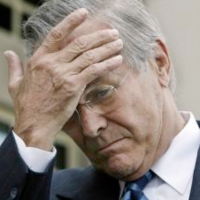With a Shout out to Donald Rumsfeld

“There are known knowns; there are things we know that we know. There are known unknowns; that is to say, there are things that we now know we don’t know. But there are also unknown unknowns – there are things we do not know we don’t know. ”
-Former Sec. of Defense Donald Rumsfeld, February 12, 2002
The context in which former Secretary of Defense Donald Rumsfeld made this observation wasn’t related to climate change, but I think he’s on to something. The unknowns, both known and unknown, create uncertainty, which serves as an impediment to our adapting to climate change.
According to FEMA, between 2000 and 2009, there were 2 major disaster declarations in the state of Connecticut. From 2009 to 2013 there have been six such declarations, including the March 2010 Nor’easter, Tropical Storm Irene, the October 2011 snowstorm and Super Storm Sandy (aka Frankenstorm). Yet some climate scientists believe it is unclear how much of a connection there is between an increase in hurricanes and climate change.
Each of these events cost municipalities money (taxpayer’s money) to repair storm damage. It cost the federal government money (taxpayer’s also) in the form of direct assistance to municipalities as well as payouts through the FEMA administered National Flood Insurance Program. These storms have raised awareness about the need to begin to take action in response to climate change sooner rather than later. The question is: what do we do that will address the issue for the long term? –because we only want to do it once. But is that even possible? To figure that out, you need to know what you’re up against.
If we know what the problem is, we can design a solution. And that’s easy to figure out: we just go to models that show us the coastal inundation levels from hurricanes, and develop a solution to protect or retreat from those areas that will be flooded. The problem is that the models are not exact predictors of the future. There are a lot of models, all with variations, that are only as good as the assumptions made for input. Which one do you use? Prior to Sandy hitting the east coast, NOAA forecaster Jim Cisco, who coined the nickname Frankenstorm, said: ‘We don’t have many modern precedents for what the models are suggesting.’ (Another meteorologist predicted that Sandy could cause as much as $1 billion in damage. He was only off by 6000 % — it cost $60 billion)
Clearly, additional modeling research would be helpful. There are some really smart people at UConn and other places that are working on other models that take into account additional factors beyond what’s included in existing models. This is a challenge because there are so many factors, and so many variations of what can happen with tides, fetch, wind direction, speed with which the storm moves, rainfall amount, etc., that it is difficult to account for all these variables in a model. For now, the Connecticut legislature has decided that the NOAA model should be used. At least this will give municipal officials in Connecticut something on which to base climate change related decisions as they start to develop policy and regulations.
In addition to storm predictions there are predictions of sea level rise (SLR). These models also vary widely, creating more uncertainty. Consider that Tropical Storm Irene had surge levels that exceeded the levels of the infamous Category 3 1938 Hurricane. During Tropical Storm Sandy, some areas of Bridgeport were inundated to an extent predicted for a Category 2 hurricane!
So what’s a community to do? There is no easy answer, but a start is to recognize that these issues are going to cost a community money, and taking preventative measures now will save money in the long run. Doing the easy, obvious things (sometimes called “no regrets” actions) first makes a lot of sense. A lack of certainty about the future is not something that should hold us back from taking action now.
In 2007, Oregon high school science teacher Greg Craven made an excellent argument for taking action even though we don’t know what is going to happen. He argues that the risk of not acting far outweighs the risk of acting. Think of it as risk based insurance to protect ourselves from a catastrophe if we make the wrong choice. It can be found here: http://www.youtube.com/watch?v=mF_anaVcCXg and is worth the time it takes to watch. Since then he has gone on to publish a book and lecture on climate change.
It is not only uncertainty that acts as an impediment to our willingness to invest in adaptation for the future of the planet. Sometimes the opposite, certainty, does the same thing. Researchers David Barker of the University of Pittsburgh and David Bearce of the University of Colorado published an article in the June issue of Political Research Quarterly which states that a belief in biblical end times plays a role in shaping our reaction to climate change. Their research shows that “a belief in the Second Coming [of Jesus] reduces the probability of strongly agreeing that the government should take action [to curb global warming] by more than twelve percent.” As Barker and Bearce explain, “It stands to reason that most nonbelievers would support preserving the Earth for future generations, but that end-times believers would rationally perceive such efforts to be ultimately futile, and hence ill-advised.” This is a view shared by a significant percentage of the population. Who knows, they may be right. But then again, even if the end times are coming we don’t know when. It could be a long time. So, is this really a reason not to act?
We know we don’t know the exact timing or precise location and level of the impacts of climate change. There are a lot of known unknowns and that is scary enough. What is truly frightening is what we don’t know we don’t know.